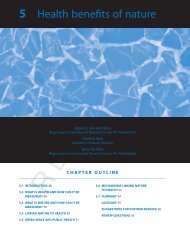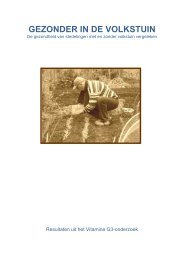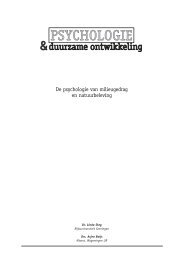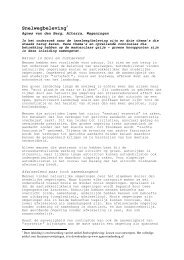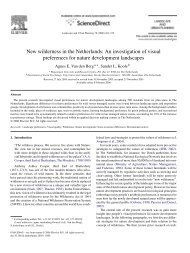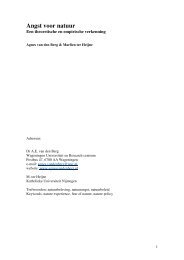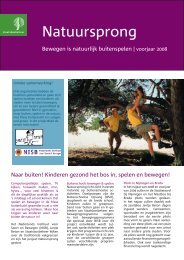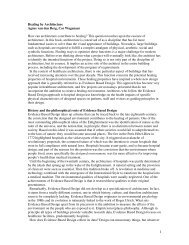Is love for green in our genes? - Agnes van den Berg
Is love for green in our genes? - Agnes van den Berg
Is love for green in our genes? - Agnes van den Berg
- No tags were found...
Create successful ePaper yourself
Turn your PDF publications into a flip-book with our unique Google optimized e-Paper software.
RESS6 Y. Joye, A. <strong>van</strong> <strong>den</strong> <strong>Berg</strong> / Urban Forestry & Urban Green<strong>in</strong>g xxx (2011) xxx–xxxIntercultural agreement po<strong>in</strong>ts to universalityA first argument starts from the observation that research<strong>in</strong> different countries reveals substantial <strong>in</strong>tercultural agreement<strong>in</strong> preferences <strong>for</strong> natural environments. Based on thisobservation, it is stated that positive affective responses to natureare universally shared, which renders evolutionary explanations ofsuch responses more plausible than cultural and personallearn<strong>in</strong>g perspectives (e.g., Ulrich, 1993, p. 97). One difficultywith this argument <strong>for</strong> universality is that it relies almostexclusively on research on (fairly elaborate) aestheticpreferences <strong>for</strong> nature, which, as we have expla<strong>in</strong>ed be<strong>for</strong>e,probably tap <strong>in</strong>to different processes than restorative responses.Another difficulty is that the available cross- cultural research doesnot seem to cover the full breadth of human diversity. Specifically,(Lewis, 2005, p. 90) notes that populations that are the subject ofmany preferential studies are often histor- ically and ethnicallyrelated (e.g., Americans vs. Australians), and those who are not aremostly still urban or suburban resi<strong>den</strong>ts, with highly similar natureexperiences. A notable exception seems to be the recent Falk andBall<strong>in</strong>g (2010) study, which found that Nigerian subjects who areunacqua<strong>in</strong>ted with sa<strong>van</strong>nahs prefer this type of biome, overother (more familiar) biomes. Accord<strong>in</strong>g to Falk and Ball<strong>in</strong>g thisreplication of their earlier results (see Ball<strong>in</strong>g and Falk,1982, p. 11) with non-western <strong>in</strong>dividuals suggests that <strong>our</strong> species“.. . beg<strong>in</strong>[s] life with a preference <strong>for</strong> sa<strong>van</strong>na-like environments”.While the available cross-cultural research unquestionably yieldsvaluable <strong>in</strong>sights, much more research with non-western(ized)samples and more direct measures of restoration are neededbe<strong>for</strong>e a claim to universality of restorative responses can bejustified.Biophobia supports phytophiliaA second argument, put <strong>for</strong>ward by Ulrich (1993), starts off fromthe claim that <strong>our</strong> evolved human nature conta<strong>in</strong>s defence mechanismsaga<strong>in</strong>st certa<strong>in</strong> natural threats, such as snakes or spiders.Based on the assumption that such “biophobic” responses constituteonly one half of a “‘symmetric’ biophobia/biophilia framework”(Ulrich, 1993, p. 88), Ulrich concludes that natural selection mustalso have endowed humans with mechanisms that make themrespond positively to natural entities that were beneficial to theirreproductive fitness. In a nutshell, Ulrich believes that proposals <strong>for</strong>an <strong>in</strong>nate predisposition <strong>for</strong> (among others) phytophilia “. . . ga<strong>in</strong>plausibility and consistency if they also postulate a correspond<strong>in</strong>ggenetic predisposition <strong>for</strong> adaptive biophobic responses to certa<strong>in</strong>natural stimuli that presumably have constituted survival-relatedthreats throughout human evolution (Ulrich, 1993, p. 75).We th<strong>in</strong>k that the previous argument is flawed <strong>for</strong> two reasons.First, it needs to be kept <strong>in</strong> m<strong>in</strong>d that the extent to which biophobicresponses are actually “hardwired” is still debated (e.g., Blanchette,2006). By extension, one should be careful about consider<strong>in</strong>gpositive affective responses to <strong>green</strong>ery as <strong>in</strong>nate or biologicallyprepared, especially s<strong>in</strong>ce biophobic responses are explicitly studiedto shed light on their possible evolved orig<strong>in</strong>s, while thisis not, or only marg<strong>in</strong>ally the case <strong>for</strong> the <strong>for</strong>mer (cfr., M<strong>in</strong>ekaand Öhman, 2002). A second issue is that there probably is nosuch th<strong>in</strong>g as a “‘symmetric’ biophobia/biophilia framework”. Itrather seems to be the case that organisms are predom<strong>in</strong>antlydisposed to be hardwired to attend to and respond to threaten<strong>in</strong>grather than to nonthreaten<strong>in</strong>g stimuli/situations. This is becausefail<strong>in</strong>g to negoti- ate encounters with negative events/elementswill have had much higher fitness costs (i.e., death) than fail<strong>in</strong>g tonegotiate encoun- ters with positive elements/events(Baumeister et al., 2001). This “negativity bias” <strong>in</strong> evolution thusunderm<strong>in</strong>es the claim that the existence of a PRM ga<strong>in</strong>splausibility from the existence of <strong>in</strong>nate biophobic responses.But suppose, <strong>for</strong> the sake of the argument, that there<strong>in</strong>deed is a symmetric biophobia/biophilia framework and thatbiophobic responses are truly hardwired. Even then, it still needs tobe further expla<strong>in</strong>ed and empirically justified why specificallyphytophilic responses – and not some other type of positiveresponse to nature– constitute the symmetric counterpart of biophobicresponses. As should have become clear from the previoussections, current empirical research and theoretical argumentsstruggle to provide such a justification. It appears that the“biophobia means biophilia argument” can barely provide anyadditional support <strong>for</strong> the via- bility of the hardwired character ofthe PRM (see also: Joye and De Block, 2011 <strong>for</strong> a lengthierexposition of this specific argument).Restorative responses to nature and perceptual fluencyAs discussed <strong>in</strong> the <strong>in</strong>troductory sections of this paper, SRT’s coreassumption is that phytophilic elements can quickly offset positiveaffective responses, which are able to attenuate stress. While <strong>in</strong>SRT’s psycho-evolutionary framework such positive responses aredeemed to be adaptive remnants of human evolution <strong>in</strong> naturalenvironments, we hope to have demonstrated that this evolutionaryaccount has clear shortcom<strong>in</strong>gs. It should yet be granted toUlrich that his psycho-evolutionary account of restoration at leastconstitutes an attempt to provide a detailed answer to the questionof why restorative responses to nature ultimately occur. Thiscontrasts, <strong>for</strong> example, with Stephen Kaplan’s rather crude viewon the ultimate orig<strong>in</strong>s of restoration: “The way I th<strong>in</strong>k of it is that<strong>our</strong> ancestors evolved <strong>in</strong> a nature-filled environment.. [and that, asa result, such places] should feel more com<strong>for</strong>table, more relaxed,more like home” (cited <strong>in</strong>: Jaffe, 2010, p. 12). Instead of such generalstatements, we are <strong>in</strong> need of a f<strong>in</strong>e-gra<strong>in</strong>ed causal accountthat actually addresses the question of how restorative responsescome about.One of the authors of the current article has tried to tackle thequestion of why unthreaten<strong>in</strong>g environments trigger positive affectiveresponses by relat<strong>in</strong>g such responses to research on process<strong>in</strong>gfluency (Joye, 2007). Process<strong>in</strong>g fluency is commonly def<strong>in</strong>ed as thesubjective experience of the ease with which a certa<strong>in</strong> stimulusorganization is processed. Research shows that fluent process<strong>in</strong>gis commonly accompanied by positive affect, which is af<strong>in</strong>d<strong>in</strong>g that is ascribed to the fact that fluency po<strong>in</strong>ts out that“good” and efficient stimulus process<strong>in</strong>g is tak<strong>in</strong>g place or thatsufficient cog- nitive res<strong>our</strong>ces are available to deal with a certa<strong>in</strong>stimulus (Reber et al., 2004). Build<strong>in</strong>g on this fluency literature, thePerceptual Flu- ency Account (PFA) of restoration states thatunthreaten<strong>in</strong>g natural scenes are affectively evaluated morepositively than unthreaten- <strong>in</strong>g urban scenes because <strong>our</strong> visualsystem more fluently processes certa<strong>in</strong> aspects of the visualstructure of the <strong>for</strong>mer than of the lat- ter (see also Redies, 2007).Accord<strong>in</strong>g to PFA, restoration is – much like <strong>in</strong> SRT – the result of an“undo<strong>in</strong>g process” <strong>in</strong>itiated by positive affect, but <strong>in</strong> the case ofPFA the affective response is due to fluent process<strong>in</strong>g rather than toobscure evolutionary factors. Because PFA posits a process<strong>in</strong>gad<strong>van</strong>tage of natural/<strong>green</strong> sett<strong>in</strong>gs over urban scenes, it expectsthat process<strong>in</strong>g the <strong>for</strong>mer will require less cog- nitive res<strong>our</strong>cesthan the latter, which con<strong>for</strong>ms to the f<strong>in</strong>d<strong>in</strong>g that exposure tonature is superior <strong>in</strong> counteract<strong>in</strong>g attention depletion than urbanscenes (Kaplan and Kaplan, 1989).In a nutshell, PFA views attention restoration and stress reduction(to a considerable extent) as by-products of fluent process<strong>in</strong>g.This theoretical account should, however, not be considered as a“paradigm shift” <strong>in</strong> restorative environments research. The accountrather br<strong>in</strong>gs ideas to the <strong>for</strong>eground, which have been present<strong>in</strong> this field of research <strong>for</strong> quite some time, and it relatesthem to research on process<strong>in</strong>g fluency. For example, the coreidea of PFA is already present <strong>in</strong> ART, where the restorativeconstruct



